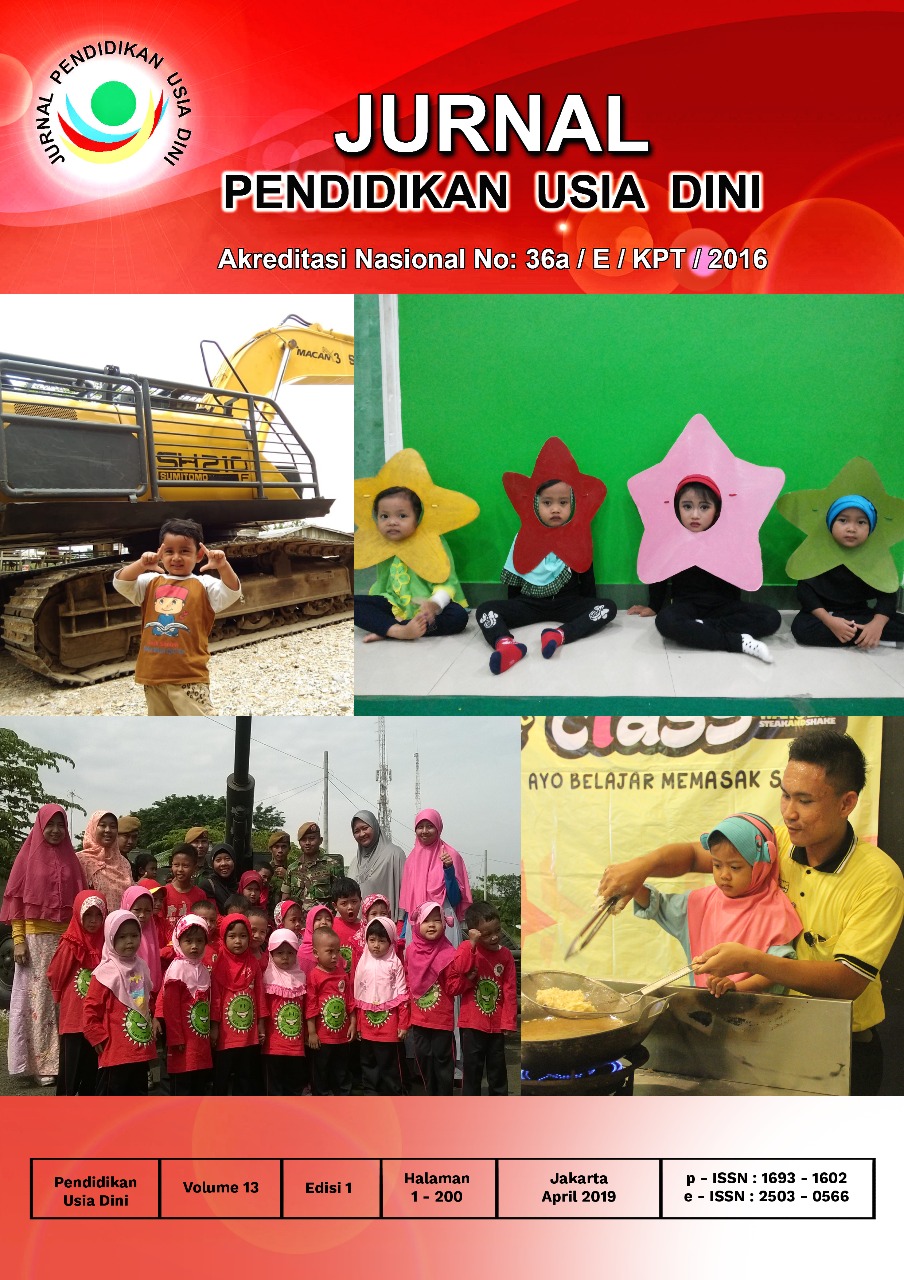Whole-Language Approach: Improve the Speaking Ability at Early years School Level
DOI:
https://doi.org/10.21009/10.21009/JPUD.131.02Abstract
The purpose of this study was to find out the information whether the whole language ap-proach can improve the speaking ability for third-grade students’ elementary school. The subjects of this study were 22 of the third-grade students of elementary school Rawamangun, East Jakarta. The method of the study was action research conducting using model of Kemmis and Taggart. Data collection and analysis using data triangulation techniques. The results of the study show that speaking ability is one of the important skills used to communicate so it needs to be developed for grade 3 elementary school students. The result showed that the whole language approach can be applied as a method in improving students' speaking ability for third-grade elementary school. Therefore, teachers need to develop a whole language approach to language learning. So that it, can improve students' speaking ability.
Keywords: Elementary student 1stgrade, Speaking ability, Whole language approach
References
Abu-Snoubar, T. K. (2017). On The Relationship between Listening and Speaking Grades of AL-Balqa Applied University English as a Foreign Language Students. International Education Studies, 10(12), 130. https://doi.org/10.5539/ies.v10n12p130
Bayat, S. (2016). The effectiveness of the creative writing instruction program based on speaking activities (CWIPSA). International Electronic Journal of Elementary Education, 8(4), 617–628.
Buckingham, L., & Alpaslan, R. S. (2017). Promoting speaking proficiency and willingness to communicate in Turkish young learners of English through asynchronous computer-mediated practice. System, 65, 25–37. https://doi.org/10.1016/j.system.2016.12.016
Chen, L., Cheng, J., & Chou, M. (2016). Literacy Development in Preschool Children: a Whole Language Curriculum. European Journal of Language Studies, 3(1), 24–49.
Goodman, K. (1986). What‟s whole in whole language. Portsmouth: NH: Heinemann.
Goodman, K. (2014). What’s Whole in Language in The 21 st Century? New York: Garn Press.
Harmer, J. (1991). The Practice of English Language Teaching. The 3th Edition. London and New York: Longman Inc.
Herbein, E., Golle, J., Tibus, M., Schiefer, J., Trautwein, U., & Zettler, I. (2018). Fostering elementary school children’s public speaking skills: A randomized controlled trial. Learning and Instruction, 55(October), 158–168. https://doi.org/10.1016/j.learninstruc.2017.10.008
Kemmis, S., & McTaggart, R. (1988). The action research planner (3rd ed.). Geelong, Australia: Deakin University Press.
Khodadady, E., & Shamsaee, S. (2012). Formulaic sequences and their relationship with speaking and listening abilities. English Language Teaching, 5(2), 39–49. https://doi.org/10.5539/elt.v5n2p39
Leong, L., & Ahmadi, S. M. (2017). An Analysis of Factors Influencing Learners ’ English Speaking Skill. International Journal of Research in English Education, 2(1), 34–41. https://doi.org/10.18869/acadpub.ijree.2.1.34
Macintyre, P. D., Clément, R., Dörnyei, Z., & Noels, K. A. (2011). Conceptualizing Willingness to Communicate in a L2: A Situational Model of L2 Confidence and Affiliation. The Modern Language Journal, 82(4), 545–562. https://doi.org/10.1111/j.1540-4781.1998.tb05543.x
Marzuki, M., Prayogo, J. A., & Wahyudi, A. (2016). Improving the EFL Learners’ Speaking Ability through Interactive Storytelling. Dinamika Ilmu, 16(1), 15. https://doi.org/10.21093/di.v16i1.307
Moghadam, J. N., & Adel, S. M. R. (2011). The Importance of Whole Language Approach in Teaching English to Intermediate Iranian EFL Learners. Theory and Practice in Language Studies, 1(11), 1643–1654. https://doi.org/10.4304/tpls.1.11.1643-1654
Ngalimun, & Alfulaila. (2014). Pembelajaran Keterampilan Berbahasa Indonesia. Yogyakarta: Aswaja Pressindo.
Nunan, D. (2018). Teaching Speaking to Young Learners. In The TESOL Encyclopedia of English Language Teaching (First Edit). John Wiley & Sons, Inc. https://doi.org/10.1002/9781118784235.eelt0715
Park, Hyesook & Lee, A. R. (2014). L2 learners’ anxiety. Comp. Educ., 50(1), 45–57. https://doi.org/10.1080/03050068.2013.871832
Phadung, M., Suksakulchai, S., & Kaewprapan, W. (2016). Interactive whole language e-story for early literacy development in ethnic minority children. Education and Information Technologies, 21(2), 249–263. https://doi.org/10.1007/s10639-014-9318-8
Saepudin, E., Sukaesih, S., & Rusmana, A. (2018). Peran Taman Bacaan Masyarakat (Tbm) Bagi Anak-Anak Usia Dini. Jurnal Kajian Informasi Dan Perpustakaan, 5(1), 1. https://doi.org/10.24198/jkip.v5i1.10821
Schwarzer, D. (2001). Whole language in a foreign language class: From theory to practice. Foreign Language Annals, 34(1), 52–59. https://doi.org/10.1111/j.1944-9720.2001.tb02802.x
Seong, Y. (2017). Assessing L2 Academic Speaking Ability: The Need for a Scenario-Based Assessment Approach. Working Papers in Applied Linguistics & TESOL, 17(2), 36–40.
Stark, H. L., Snow, P. C., Eadie, P. A., & Goldfeld, S. R. (2016). Language and reading instruction in early years’ classrooms: the knowledge and self-rated ability of Australian teachers. Annals of Dyslexia, 66(1), 28–54. https://doi.org/10.1007/s11881-015-0112-0
Tarigan, & Guntur, H. (1981). Berbicara Sebagai Suatu Keterampilan Berbahasa. Bandung: Angkasa.
Tuan, N. H., & Mai, T. N. (2015). Factors Affecting Students’ Speaking Performance at Le Thanh Hien High SchoolTuan, N. H., & Mai, T. N. (2015). Factors Affecting Students’ Speaking Performance at Le Thanh Hien High School. Asian Journal of Educaitonal Research, 3(2), 8–23. Asian Journal of Educaitonal Research, 3(2), 8–23.
Ur, P. (1996). A course in Language Teaching. Practice and Theory. Cambridge: Cambridge. University Press.
Walter, C. (2010). Teaching ESL/EFL Listening and Speaking,. System, 38(1), 144–146. https://doi.org/10.1016/j.system.2009.11.002
Weaver, C. (1990). Understanding Whole Language from Principles to Practice. Toronto: Irwin Publishing.
Wood, C., Fitton, L., Petscher, Y., Rodriguez, E., Sunderman, G., & Lim, T. (2018). The Effect of e-Book Vocabulary Instruction on Spanish–English Speaking Children. Journal of Speech, Language, and Hearing Research, 61(8), 1945–1969. https://doi.org/10.1044/2018_jslhr-l-17-0368
Yegani, H. (2017). The Effect of Task-based and Topic-based Speaking Activities on Speaking Ability of Iranian EFL Learners, 85–93.
Downloads
Published
How to Cite
Issue
Section
License
JURNAL PENDIDIKAN USIA DINI work is licensed under a Creative Commons Attribution 4.0 International License. (http://creativecommons.org/licenses/by/4.0/)





